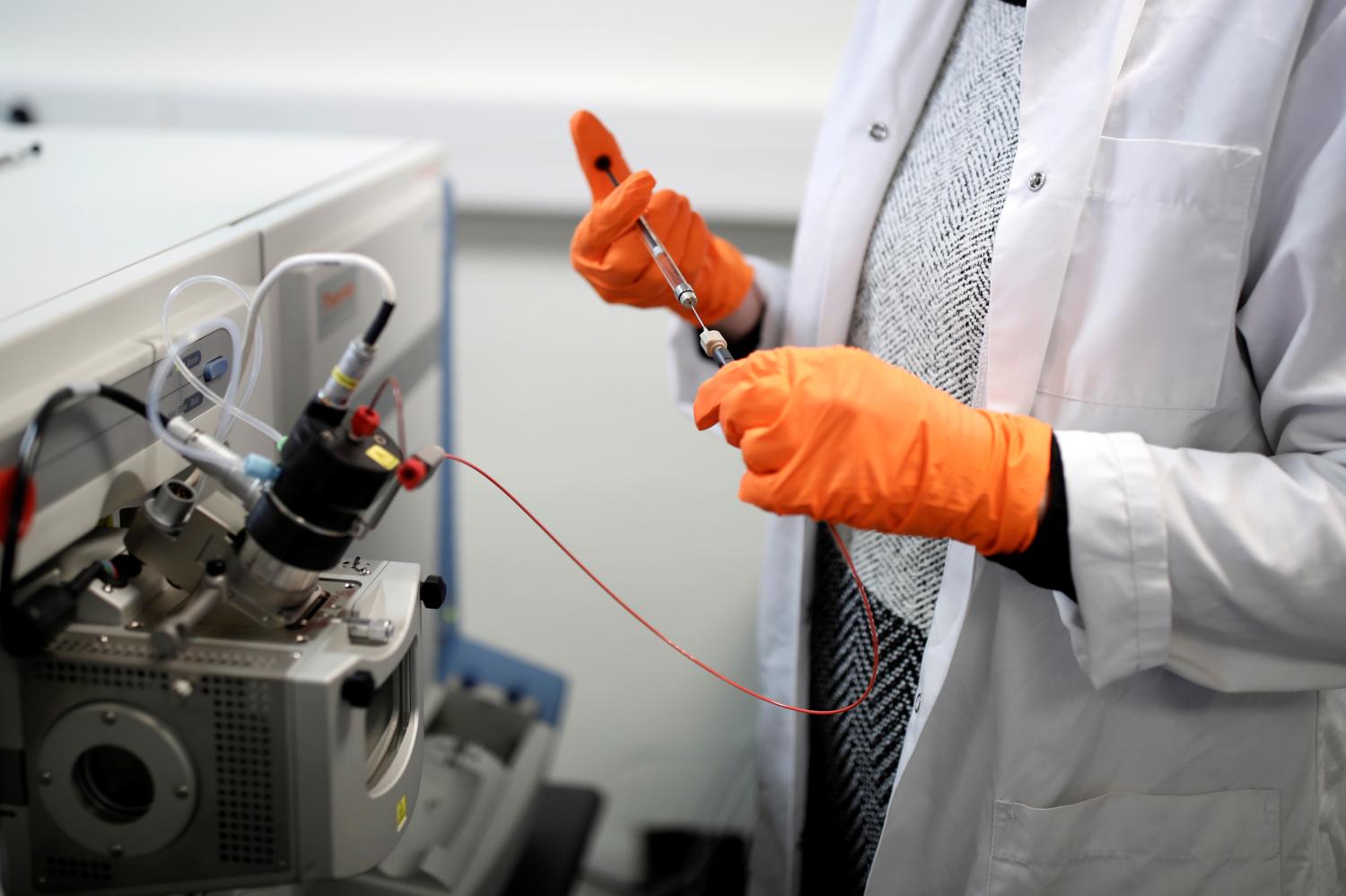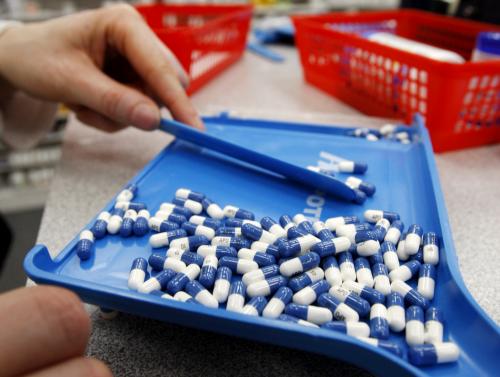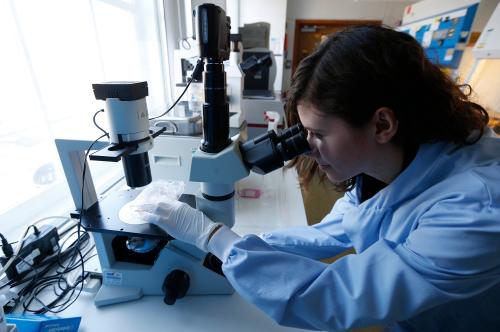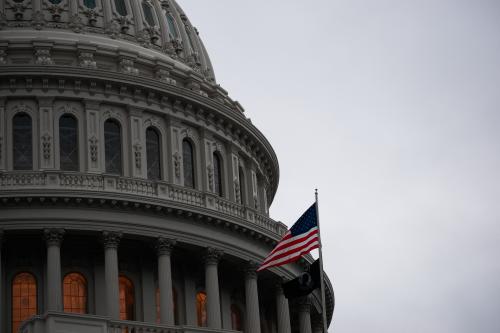This policy brief was prepared for “Reining in prescription drug prices,” a May 2 event presented by the Center for Health Policy and the Hutchins Center on Fiscal and Monetary Policy at Brookings.
Americans spend roughly $1 billion a day on prescription drugs. Sharp increases in U.S. spending on prescription drugs—the Center for Medicare and Medicaid Services (CMS) projects that it will rise 6.3% per year on average over the next decade—are a subject of substantial political and economic concern. Because the U.S. government pays more than 40% of all retail prescription drug costs, such increases will put pressure on an already-stressed federal budget. They will also contribute to rising private health insurance premiums, increasing costs for employers and workers.
Recent spending increases reflect both a bevy of new drugs, targeting Hepatitis C, cancer, and other severe illnesses, and rising prices for old drugs.
A key policy challenge is finding ways to restrain the prices of prescription drugs without discouraging the development of new drugs that could have substantial health benefits. To suggest policy options, the Hutchins Center on Fiscal and Monetary Policy and Center for Health Policy at Brookings commissioned three papers: “A Framework for Negotiation in Part D of Medicare” by Richard G. Frank and Richard J. Zeckhauser; “Can Drug Importation Address High Generic Drug Prices?” by Thomas. J. Bollyky and Aaron S. Kesselheim; and “Enabling Competition in Pharmaceutical Markets” by Fiona Scott Morton and Lysle T. Boller. This policy brief draws from those papers.
Challenge 1: Medicare Part D insurers and consumers have little incentive to avoid the highest-cost drugs.
Medicare Part D prescription drug insurance, which covers 41 million people, includes significant cost-sharing on the part of consumers for most beneficiaries: there is a $400 deductible and a 25 percent co-pay on annual spending of $3,700, and then the beneficiary enters the “donut hole” where the person has to cover 100 percent of the costs. But after someone with Medicare Part D spends $4,950 out of pocket, they pay only 5 percent of the costs, the insurer pays 15 percent and the federal government bears the remaining 80 percent. Because the government shields private insurers who sell the coverage from bearing much risk, this is called the “reinsurance region.” About one in every 10 Part D beneficiary spends enough to enter into the reinsurance region. The share of spending covered in the reinsurance region has grown sharply over time: In 2007, federal spending in this region accounted for about 25 percent of Part D per enrollee costs. In 2017, it was more than 55 percent. The increase reflects not an increase number of prescriptions, but an increase in the average price of the drugs.
This structure gives insurers and consumers little incentive to use alternatives to high-priced drugs that might be just as efficacious as costlier drugs. Medicare requires insurers to cover all drugs in certain protected classes—nearly all cancer drugs, for example—and at least two drugs for every other class, giving insurers little flexibility to favor cheaper drugs, In addition, Congress prohibits the government from negotiating directly for better prices.
Proposed solution: Congress should increase the insurer’s share of payments in the reinsurance region. Then, it should permit the government to negotiate payments for drugs that don’t face much competition and are covered by Part D. These negotiations should use the following framework: (1) The government should decide upon a base price that covers a substantial portion of the research and development costs of the drug manufacturer, and (2) negotiate a bonus addition to that price based on the benefits that the new drug provides. The creators of this approach, Richard Frank and Richard Zeckhauser of Harvard, say it would preserve the incentives for innovation while allowing the government to limit the excessively high prices that result from the absence of market forces.
For more, see Frank and Zeckhauser.
Challenge 2: The generic drug market periodically experiences temporary shortages and massive price spikes.
The number of drug shortages increased from 154 to 456 between 2007 and 2012. In most cases, the under-supplied drugs were generics, many of which were made by only a few manufacturers. Because these manufacturers had significant market power, they were able to push up prices when, for example, competitors were hit by manufacturing problems that lowered the quantities they could produce.
One obvious remedy for this problem is for new manufacturers to enter the market when there are shortages. However, because drug companies must submit Abbreviated New Drug Applications (ANDAs) to the Food and Drug Administration (FDA) to be able to sell their generics, it takes time before new manufacturers can enter the market, resolve shortages, and push prices back down.
Proposed solution: The FDA should work with drug regulators in other countries to create a common portal through which drug companies can easily submit applications to manufacture generic drugs. This wouldn’t mean that the regulators would make joint decisions about whether to approve an application, but would streamline the information gathering process so that more drug companies would apply. The FDA should also work with high-quality foreign regulators—such as those in Canada, the European Union, the United Kingdom, Japan, etc.—to allow reciprocal drug approval for generics, meaning that if another country approved a generic drug, that drug could be sold in the U.S. as well.
For more, see Bollyky and Kesselheim.
Challenge 3: Brand-name biologic drug prices continue to rise because there are too few generic competitors.
Biologic drugs—or complex, large-molecule drugs grown from tissue—comprise more than a quarter of prescription drug spending. Yet there are only five generic biologics—called biosimilars—approved for use in the U.S. Europe has approved more than 20. And no biosimilars have been granted “interchangeable” status by the FDA, which would allow pharmacists to automatically substitute them for brand-name biologics when filling prescriptions, as is currently often done with generics. The FDA does not plan to finalize its instructions on what it takes to achieve “interchangeable” status until 2019, a task given to it by legislation in 2010.
Proposed solution: The FDA should approve more biosimilars, and finalize its guidance on how biosimilars can gain “interchangeable” status.
For more on this and the next seven proposals, see Scott Morton and Boller.
Challenge 4: Current biosimilar naming practices make it hard for physicians and pharmacists to know which biologic drugs have cheaper equivalent (generic) biosimilars.
The FDA recently approved guidance that stated that biosimilar drugs must have four randomly assigned letters appended to their names so that it is easy to tell them apart from the reference drug, and thus easy to track in case there are problems. This may sound inconsequential, but according to Scott Morton and Boller, it “creates problems for bodies that administer directories of drugs, those who design formularies, and those who wish to sort available drugs to find out what alternative treatments are available.” Such naming practices confuse doctors, pharmacists, and consumers, and may make it less likely they will realize that the relevant biologic and biosimilar are equivalent, “thereby preventing efficient substitution, slowing biosimilar market penetration, and maintaining higher prices.”
Proposed solution: The FDA should follow the recommendations of the World Health Organization and give equivalent biologics and biosimilars the same root names.
Challenge 5: Coupons offered by drug companies to consumers interfere with incentives for lower-cost alternative drugs.
Insurers often require higher co-pays for more expensive drugs to encourage consumers to choose cheaper alternatives. Sometimes drug companies offer coupons to cover the higher co-pays, undoing the incentive. This practice is barred in Medicare and Medicaid, and is illegal for all drug insurance in Massachusetts.
Proposed solution: States should ban these coupon practices.
Challenge 6: Pharmacy benefit managers (PBMs) have too much market power, and at times do not have sufficiently strong incentives to negotiate for better prices on behalf of their insurance plan clients.
PBMs administer prescription drug programs for employers, insurance companies and Medicare Part D. The three largest —CVS Caremark, OptumRx, and Express Scripts—have a market share of 80% to 85%.
PBMs receive a share of the rebates they negotiate with drug manufacturers so they have an incentive to keep list prices high. That way, they can “bargain” for a discount more easily, but the discounts they get are usually not disclosed to their customers and may not be passed on to them.
Proposed solution: Stimulating more competition would make it difficult for PBMs to maintain this practice. The Federal Trade Commission (FTC) should take anti-trust action against the largest PBMs, and should consider requiring PBMs to deliver rebates to the plans on whose behalf they are acting.
Challenge 7: Drug companies can profit from their “charitable” activities.
Drug companies get a tax deduction when they donate to outside patient assistance programs (PAPs). In many cases, those programs cover the co-pay for eligible consumers who purchase the donating drug company’s drug. This effectively leverages the drug company’s donation, yielding a profit for the drug company from its charity.
Drug companies can also form their own PAPs, often structured as foundations, to which they donate drugs, gaining a tax deduction equal to the cost of the drug plus half the market value. These drugs often go to individuals who would not purchase them otherwise, but once started on a regimen, will continue on it even when the PAP is no longer providing the drug.
Of the 15 highest-donating foundations in the U.S. in 2014, 10 of them were drug company charities.
Proposed solution: Congress should legislate that, if a charitable contribution leads to net profits for a firm, it cannot count as a tax deduction. Additionally, in-kind donations to drug foundations should either qualify for deductions equivalent to the drugs’ cost, or not qualify for any deduction at all.
Challenge 8: Drug manufacturers get “orphan drug” benefits in ways that lead to less competition without commensurate societal benefits.
The Orphan Drug Act of 1983 was passed to encourage drug manufacturers to create drugs for markets too small to be profitable, particularly for diseases which affect few people. FDA can award extra years of market exclusivity to these so-called “orphan drugs,” along with other financial benefits and easier regulatory treatment. More than half of all new drugs are approved for these orphan populations and over half of orphan approvals are first-in-class, meaning no other approved treatment exists.
However, in some cases, the system is being abused. As Scott Morton and Boller describe it, “some prescription medicines obtain orphan status years after they originally gained FDA approval to treat a certain broad indication… Manufacturers can then run a clinical trial on a small off-label use, prove effectiveness, gain orphan status, and raise price significantly.” While these additional tests do have some societal value, such add-on approvals do not merit the strong incentives that new orphan drugs deserve, particularly when drug companies repeatedly search for artificially narrow disease populations that they can serve to claim these benefits.
Additionally, orphan drug status relieves manufacturers from the requirement to sell at a discount to hospitals and clinics serving lower income communities.
Proposed solution: Congress should amend the Orphan Drug Act to award stronger benefits to new drugs than to those already approved and to prevent drugs from repeatedly qualifying for orphan drug exclusivity.
Challenge 9: Manufacturers of brand-name drugs sometimes make it hard for generic drug manufacturers to obtain samples of brand-name drugs, obstructing generic manufacturers’ efforts to duplicate them.
If a generic company cannot get samples of a brand-name drug, it cannot recreate it in generic form, giving brand-name drug manufacturers an incentive to prevent generic companies from getting samples. Drugs can face FDA-imposed “risk evaluation and mitigation strategies” (REMS) that limit how they are distributed, and in other cases, drug companies can choose to impose REMS limits on themselves. Such REMS limits can take many forms—for example, they can require that physicians be trained to give the drug, patients be monitored while taking the drug, and drugs be administered in specific settings.
Some drug companies claim that, because of these REMS, they cannot sell drug samples to anyone but patients for whom they have been prescribed, even though the original legislation laying out REMS regulation stated that it should not be used as an anti-competitive tool. The legislation included no enforcement mechanism, however, so such practices persist.
Companies can patent these REMS systems, and then refuse to let generic drugs participate in them. Since doctors do not want to need to become familiar with multiple REMS systems, this can discourage the use of generic drugs, giving incumbents market power even when their drug patents have already expired.
Proposed solution: The FDA should make sure that brand-name and generic drugs can share REMS systems and that drug companies cannot self-impose REMS restrictions, the FTC should investigate REMS abuses, and makers of brand-name drugs should be required to sell samples of their drugs to generic drug companies at market prices.
Challenge 10: Brand-name drug makers sometimes profit by paying a generic drug maker to stay out of the market, denying consumers the benefits of competition.
Lawsuits between makers of brand-name drugs and makers of generics occur frequently. The settlement often involves the generic maker paying a royalty to the maker who owns or controls the relevant patent. But sometimes the maker of the brand-name drug agrees to pay the generic maker to stay out of the market. “The generic is better off because it is sharing the brand’s profit; the brand is better off because its patent remains in force so its profit is not entirely lost; and consumers are worse off because they are denied the lower prices that result from generic entry,” Scott Morton and Boller say. The brand-name company has an incentive to make those payments to maintain its monopoly.
These tactics are especially damaging because the first company to submit an application to make a generic version of a brand-name drug qualifies for six months of exclusivity, during which no other generic can be approved for distribution. If a brand-name company pays the first generic drug maker to delay entry, other generic drug makers are kept from entering as well.
Proposed solution: The FTC should continue to challenge “pay for delay” tactics. Congress should pass legislation stating that, if two companies collude this way, the brand-name maker will lose its exclusivity and the generic won’t get first-mover exclusivity benefits. One way to identify instances of “pay for delay” would be to look for patent-cases settlements that involve a transfer of money, and not just an agreement on when the generic can enter the market.




